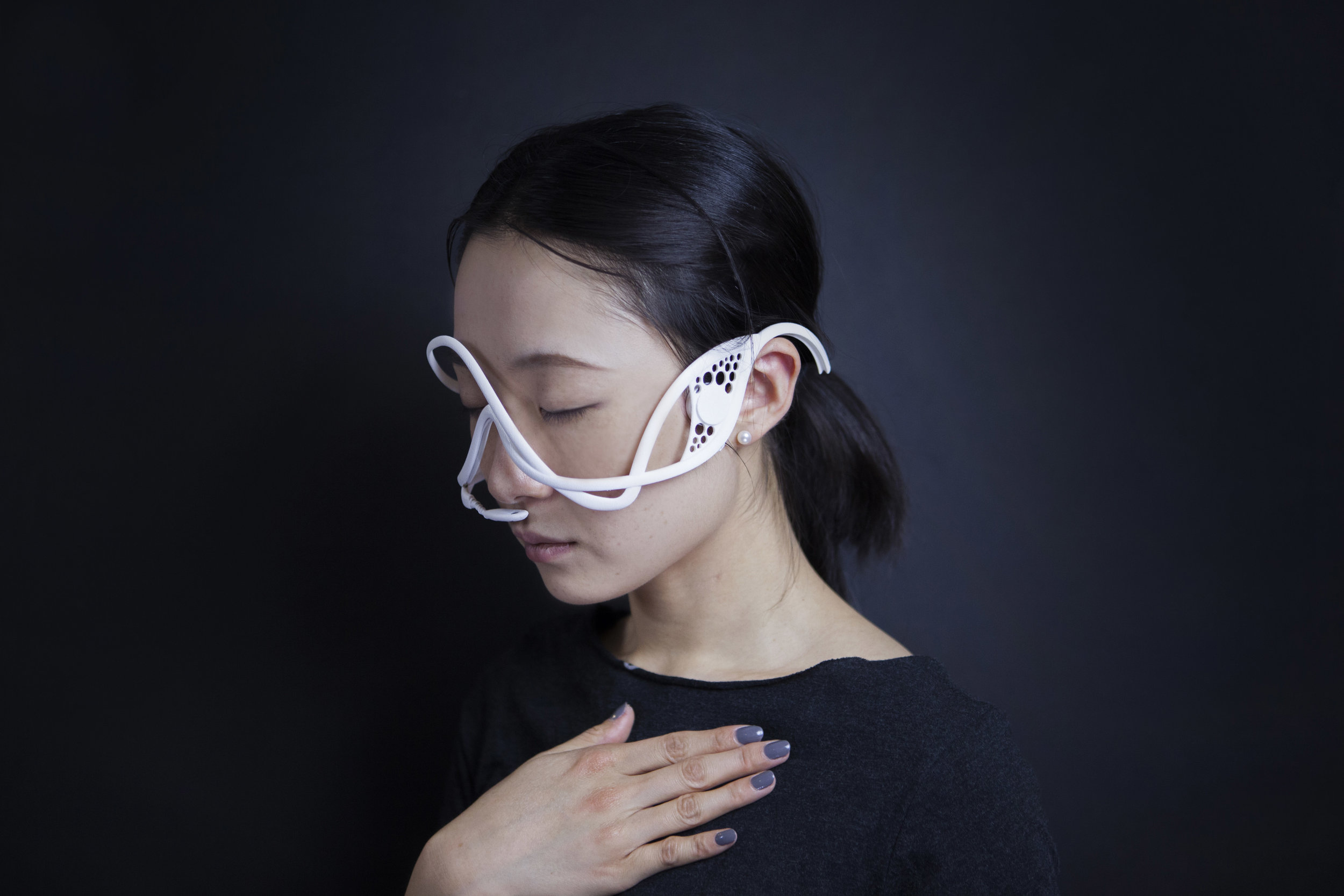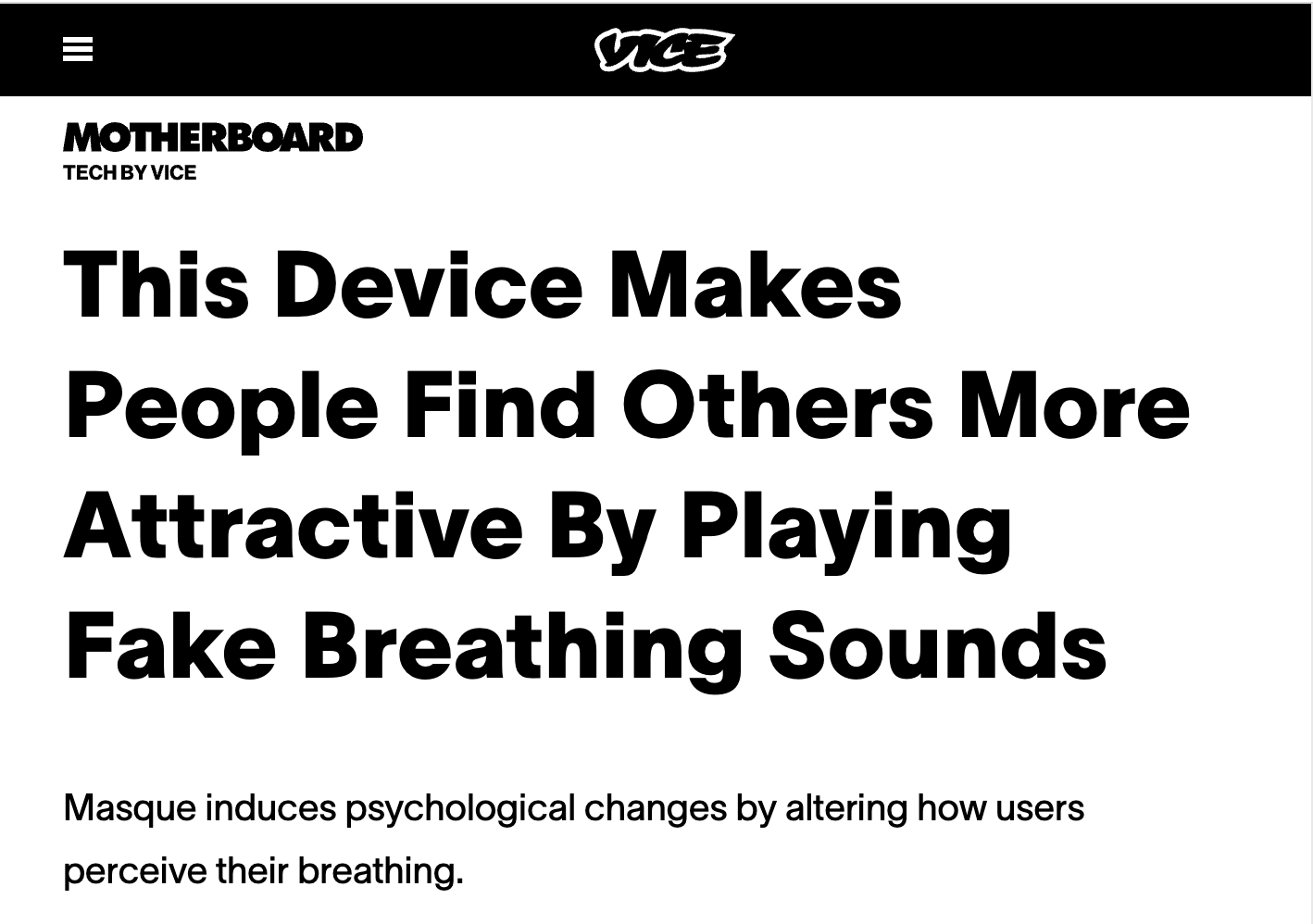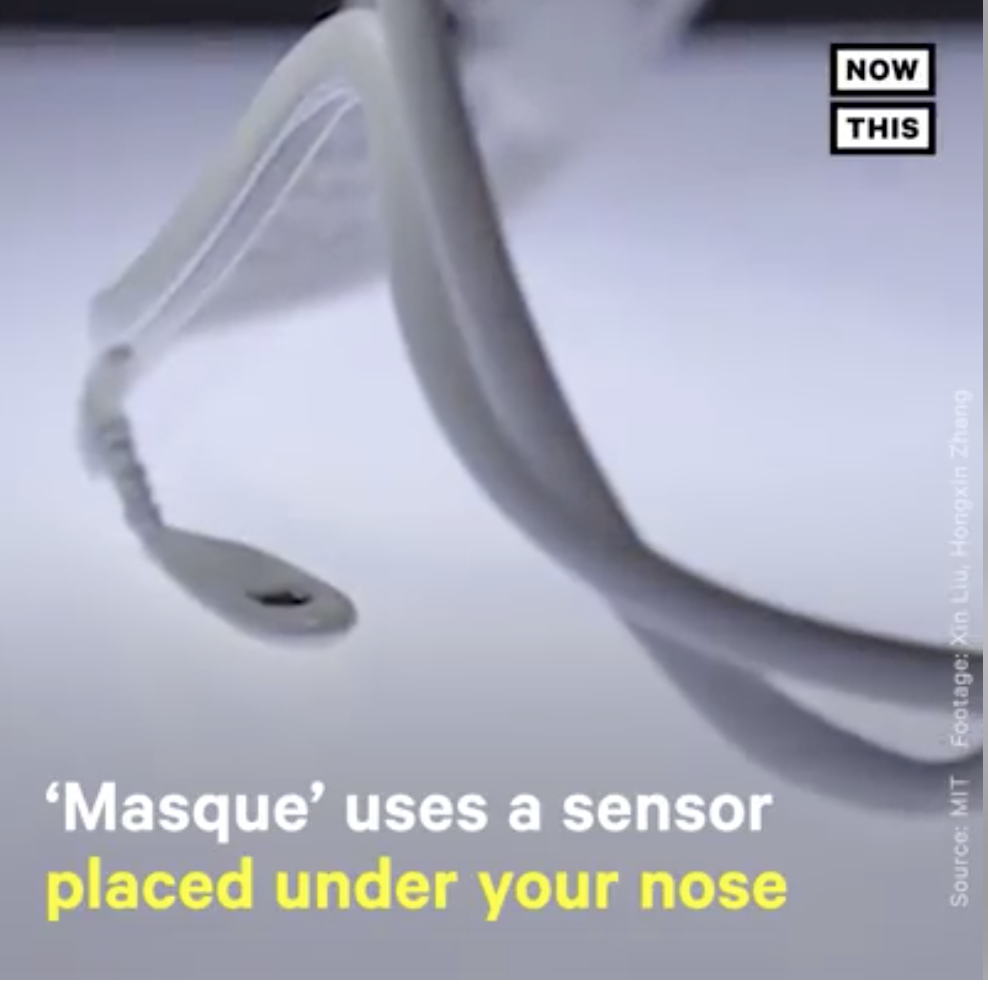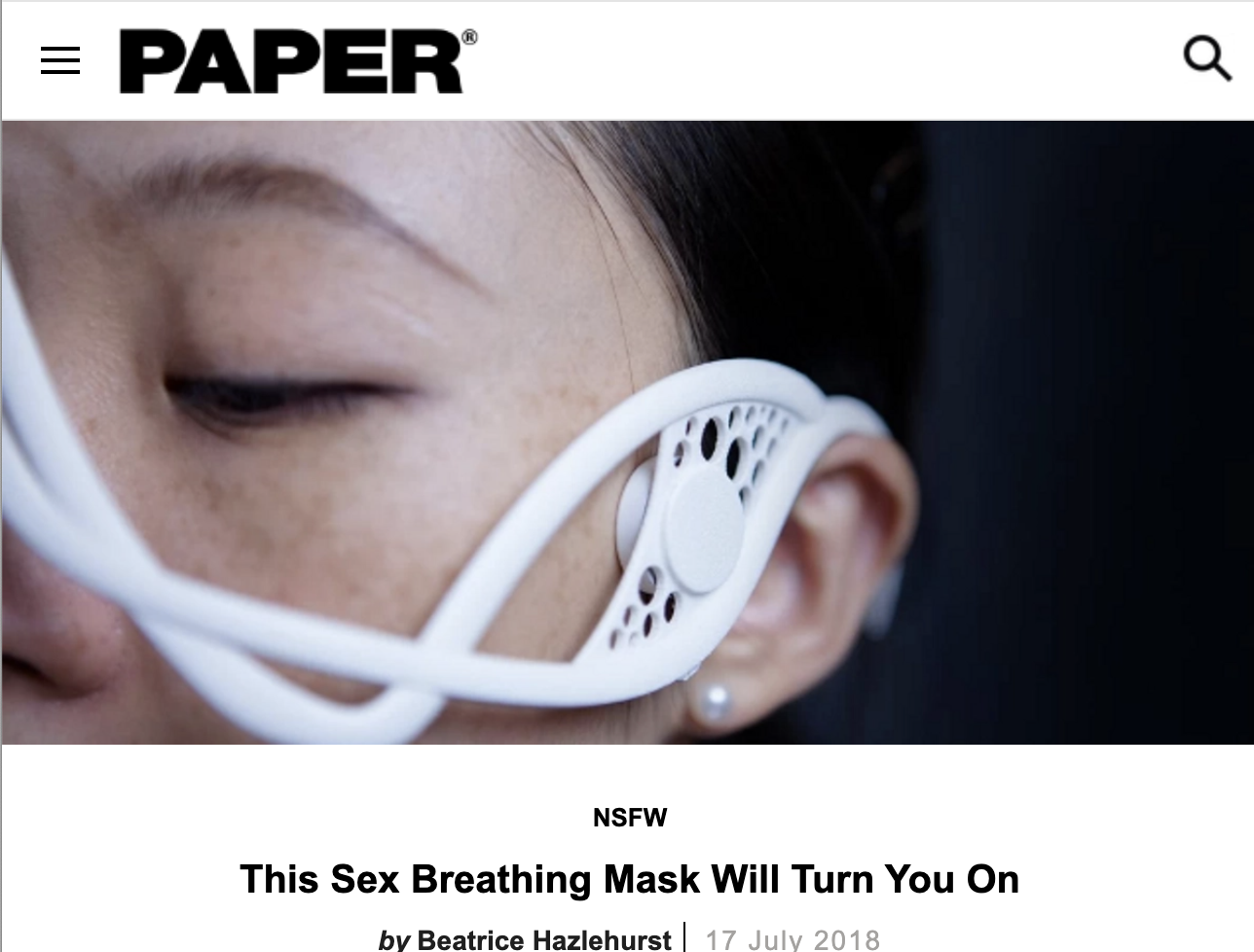Masque
Masque is a psychoacoustic system that manipulates the user’s perception of their own respiration by providing false auditory feedback.
By deliberately misrepresenting the wearer’s sense of their own breathing, Masque can cause bias in behavioral and cognitive experiences without any explicit instructions or stimuli. Users hear synchronized respiration sound from Masque as their own and react naturally to the synthetic body signals.
Masque is a compact system that manipulates the user’s perception of his/her own respiration by providing false auditory feedback. The wearable mask has respiration sensor, bone conduction speaker embedded.
The Sense of Self
〰️
The Sense of Self 〰️
When the body senses itself internally and localizes its actions, it provides the basis for a material sense of self-existence. At the same time, the mind registers the sense of an agency with free will, the sense of being, the cause of voluntary action. Among all interoceptive experiences, respiration is the only one that we can regulate directly. There are many psychophysical breathing exercises to help self-regulation and reflection, that, combined with meditation and yoga, are designed to restore natural, smooth breathing appropriate to the physical needs of the body.
Synthesized Respiration
Masque uses a digital temperature sensor chip (TSY01, TE Connectivity) for its fast data acquisition and high resolution (0.1°C) to sense respiration. The sensor measures the temperature right in front of the nostril at a frequency of 43Hz to detect the exhaling and inhaling activity of the user.
With high precision and fast speed temperature sensor, Masque detects the user's breathing activities and plays back a mediated breathing sound synchronously through a bone conduction headphone. The mediated breathing sound is real-time synthesized, thus its breathing rate can be modified by the user at any moment.
Masque measures the temperature right in front of the nostril at a frequency of 43Hz to detect the exhaling and inhaling activity of the user.
Bone conduction headphones conduct sound to the inner ear through the bones of the skull, a process which does not interfere with natural hearing through the air. The nature of bone conducted sound leads some to experience sounds as if they come from inside their own body.
Masque - hiding one’s heart
The design of Masque draws inspiration from Italian carnival masks. For critics of Commedia dell’Arte, there was a direct connection between covering one’s face and hiding one’s heart. The visual language of the mask originates in Cesare Pipa's Compendium Iconologia (1593), where the Fravde is presented as a monstrous two-headed creature. In one hand he holds a flaming, broken heart—in the other, a mask. The visual design implies the inherent tension between self-control and self-disguise in the device. Making use of its 3D printed, rigid-flexible structure , the design also learnt from Miriam Simun's smelling device for placing the sensing node in front of users' nose.
In the end, Xin Liu and industrial designer HongXin (Sean) Zhang landed on this final version that carefully conceals all the electronics—including bone conduction transducer, respiration sensor, and wires—inside a curved structure.
Our Research
We conducted two user studies on Masque, in which we observed that users easily mistook the false breathing feedback sound as their actual respiration, and showed quantifiable changes in their behaviors in both stress and sexual attraction scenarios.
Stress Study
In the Stress Study, the participants were asked to work on a GRE test within a shortened duration, before and after which we took their state-trait anxiety scores for comparison.
We observed a statistically significant difference (p =.048) in terms of changes in anxiety between the groups who heard two different rates of breathing. In other words, those who heard the fast and loud false respiration feedback tended to feel more anxious after the GRE test.
Attraction Study
We recruited twelve heterosexual, male participants in the study. They were each shown fourteen photos (publicly available) of women for 30 seconds and asked to rate each picture on the following characteristics: attractive, exciting, and friendly.
The results showed the misattribution of arousal effect for physical attraction among the participants. They rate the pictures as more attractive when they hear a fast and loud respiration sound "from themselves."
The detailed study descriptions and results can be found in the chapter five of Xin Liu's master thesis: Inward to Outward.
Masque presents a technical solution consisting of a psychoacoustic wearable interface that provides false feedback of respiratory signals and has an effect on cognitive performance. It forms a basis for a larger effort to design a body signal feedback system that changes how we perceive and connect with ourselves. By alternating various feedback patterns, we can foresee the potential of false feedback technology in areas such as emotion regulation, self-awareness, and wellbeing.
Frequently Asked Questions:
Can Masque manipulate people?
No, not entirely. Masque causes cognitive bias in people's behaviors. Just like sometimes we have less patience when we're hungry or get excited after drinking coffee, Masque shadows daily activities with a pre-context rather than direct those activities.
In fact, the development of Masque comes from Xin Liu’s research and critics on the current technologies such as quantified self and subliminal stimuli that alter our idea of self and manipulate people to make biased decisions in daily life. The rise of the quantified self has opened up uncharted territories for introspection and self-governance, where the most basic human functions such as breathing, eating, sleeping, walking, and even blinking, have become sites for monitoring and improvement. Norms proliferated by widely used devices and shared by millions of users (e.g. how many blinks per minute is optimal) form the only known maps for navigating these territories to the promised land of self-improvement. Masque, together with her thesis Inwards to Outwards, is an attempt to understand one’s relationship to herself, originating from her own life, to the discursive questions about pain and pleasure of the body, about gymnastics and junk food, about desire and repulsion we hold to.
Our making of our worlds is brutally present and active in our conceptualizations and makings of self. To me, the accuracy and programmability of manipulating body experience and human affect ought to exist with the ambiguity and ineffability in the desire of doing so. Therefore, I keep asking myself to pay very close and critical attention to what it is that is being made. At very basics of this work, it simply suggests that we pay attention to the fear, desire, ambition, and clinging that motivate the building of self identity. As the defective self is confronted, it then reminds us of the malleability of self and the unnecessity of grasping.
What is misattribution of arousal?
Misattribution of arousal is a term in psychology which describes the process whereby people make a mistake in assuming what is causing them to feel aroused. Studies have demonstrated that a person experiencing a racing heart rate induced by exercise (White and Kight, "Misattribution of arousal and attraction: Effects of salience of explanations for arousal," 1984) or fear (White, Fishbein, and Rutsein, 1981) could conflate that sensation with sexual attraction. The male subject standing in the middle of the high-altitude bridge attributes a stronger impression and even romantic preferences towards the female partner due in part to the feelings the bridge induces on the male. White has an explanation for this phenomenon: the experience of heart racing and intense breath caused by fear is similar to the physiological responses under the condition of sexual arousal.
Why did you only have male participants in the Attraction Study?
We are very aware that it is incomplete that the study is only designed around heterosexual male participants. There are several reasons for this decision: The existing literature and previous research around misattribution of sexual arousal have only presented experiments with heterosexual, male participants. I conducted a pilot study in which five female participants are asked to rate videos of male counterparts. However, the pilot results are inconclusive. We need another research topic to construct the basic foundation of the study around female participants or homosexual participants. Due to limited time and resources, we decided to focus on heterosexual, male participants as the first study group.
Awards and Press
Masque is widely reported by the media and was awarded Fast Company’s sixth annual Innovation By Design Awards in both the Students category and the Experimental category.












